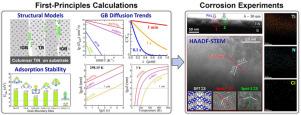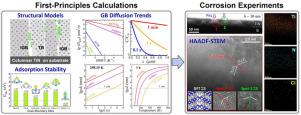氯进入TiN致密和宽开晶界的原子理解
IF 9.3
1区 材料科学
Q1 MATERIALS SCIENCE, MULTIDISCIPLINARY
引用次数: 0
摘要
腐蚀性Cl离子广泛进入TiN的晶界,导致许多实际保护/功能涂层的降解。TiN涂层中Cl离子与各种共存晶界之间相互作用的原子性质使得精确理解、预测和控制Cl离子的行为具有挑战性。本文利用第一线原理计算研究了Cl离子在许多原型晶界上的表面吸附和向内扩散,即两个致密的Σ3{112} < 110 > Σ3{112} < 110 >孪晶和四个宽开的晶间晶界(加上另外四个掺杂氧的晶界)。低的吸附自由能揭示了Cl离子在暴露晶界上的活跃表面吸附,通过计算的扩散势垒和系数发现并量化了Cl离子在晶界(孪晶界)上的快速(受阻)扩散趋势。我们的电子结构分析方法建立了共同控制这些动力学趋势的离子键和晶格变形机制。利用菲克第二定律的多尺度模拟也描绘了cl离子快速进入宽开晶间边界的过程,并统一解释了许多以前在各种TiN涂层上进行的盐腐蚀实验。我们在高孪晶TiN纳米膜上进行的盐酸腐蚀实验进一步验证了致密孪晶边界对cl离子进入的强阻断作用,并通过x射线反射仪和电子显微镜技术对其进行了精确表征。TiN纳米膜仍然会遇到Cl离子的腐蚀表面吸附,但所确定的腐蚀方式(点蚀引起的均匀变薄)的腐蚀速率非常低,为2.5×10−32.5×10−3 mm/年。本文章由计算机程序翻译,如有差异,请以英文原文为准。


Atomistic understanding of chlorine ingress into compact and wide-open grain boundaries of TiN
The ingress of corrossive Cl ions into the grain boundaries of TiN widely leads to the degradation of numerous realistic protective/functional coatings. The atomistic nature of the interaction between Cl ion and various coexistent grain boundaries in TiN coatings makes it challenging to precisely understand, predict, and control the Cl-ion behaviors. Here, the surface adsorption and inward diffusion of Cl ion on/in many prototypical grain boundaries, i.e., two compact twins and four wide-open intergranular boundaries (plus another four doped with oxygen), are studied using first-principles calculations. The active surface adsorption of Cl ion on the exposed grain boundaries is revealed by the low adsorption free energies, and the fast (blocked) Cl-ion diffusion trends on the intergranular-boundary walls (in the twin boundaries) are discovered and quantified by the calculated diffusion barriers and coefficients. The ionic-bonding and lattice-deformation mechanisms that jointly govern these kinetic trends are established by our electronic-structure analysis method. The fast Cl-ion ingress into wide-open intergranular boundaries is also portrayed by a multiscale simulation using Fick’s second law, and many previous saline-corrosion experiments on various TiN coatings are unifiedly explained. The strong blocking effect of compact twin boundaries against the Cl-ion ingress is further validated by our hydrochloric-corrosion experiment on a highly-twinned TiN nanofilm, which is precisely characterized by the X-ray reflectometry and electron microscopy techniques. The TiN nanofilm still encounters the corrosive surface adsorption of Cl ions, but the identified corrosion manner (pitting-initiated uniform thinning) presents a very low corrosion rate of mm/year.
求助全文
通过发布文献求助,成功后即可免费获取论文全文。
去求助
来源期刊

Acta Materialia
工程技术-材料科学:综合
CiteScore
16.10
自引率
8.50%
发文量
801
审稿时长
53 days
期刊介绍:
Acta Materialia serves as a platform for publishing full-length, original papers and commissioned overviews that contribute to a profound understanding of the correlation between the processing, structure, and properties of inorganic materials. The journal seeks papers with high impact potential or those that significantly propel the field forward. The scope includes the atomic and molecular arrangements, chemical and electronic structures, and microstructure of materials, focusing on their mechanical or functional behavior across all length scales, including nanostructures.
 求助内容:
求助内容: 应助结果提醒方式:
应助结果提醒方式:


